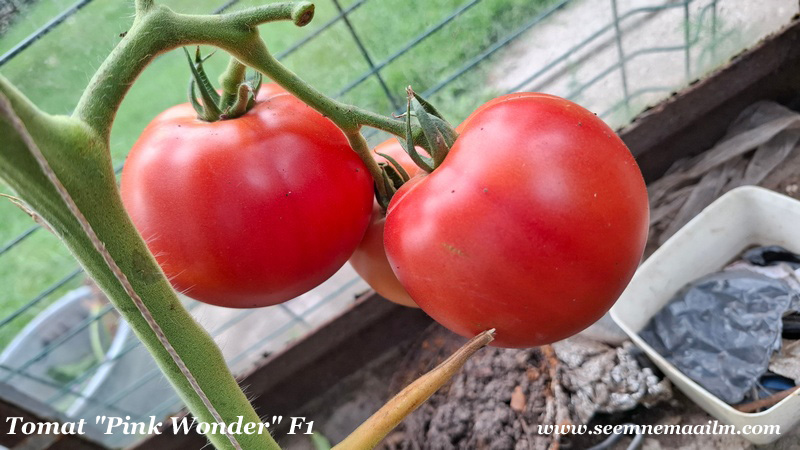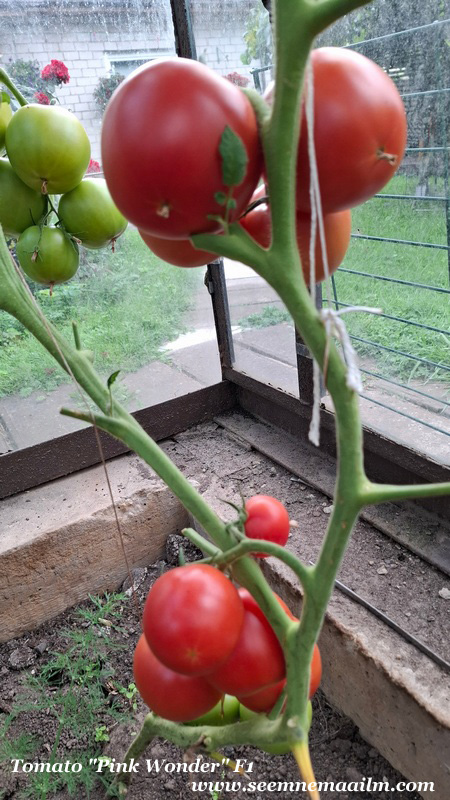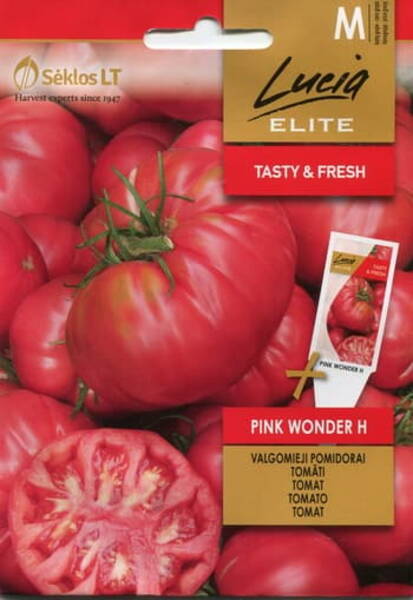Sweet and delicious.
Early ripe hybrid for cultivation in greenhouses. The plant is indeterminate (with unlimited growth).
The fruit is strongly ribbed, weighing up to 200 g. The color of the immature fruit is light green, and the mature fruit is raspberry-pink.
4-5 fruits are formed on a single cluster.
Agrotechnics.
Sowing seedlings: in March.
Pick: in the phase of the first true leaf.
Planting seedlings in greenhouses: May.
Landing pattern: 40x60 cm.
Mandatory garter plants a few days after planting. They form into one stem, removing all the "stepchildren" and lower leaves, and also pinch the growth point at the end of the growing season.

* Many amateur gardeners prefer to use only organic matter as fertilizers, believing that in this way they can get rid of nitrates. Nothing like this! They have been and will always be! Both in soil and in plants. And we cannot escape this natural process.
Nitrates are salts of nitric acid. They are highly soluble in water, migrate easily and are capable of accumulating in significant quantities in the root layer of the soil, and, consequently, in plants. Nitric acid salts are widely used as effective nitrogen fertilizers: ammonium nitrate NH4NO3, sodium nitrate NaNO3, calcium nitrate Ca(NO3)2; as well as urea (urea), where ammonia often turns into nitrate form.
When applying high doses of nitrogen fertilizers, even those that do not contain salts of nitric acid (nitrates), for example, ammonia, large amounts of nitrates can nevertheless accumulate in the soil, also as a result of the nitrification process.
It is important that nitrates do not accumulate in plants in excess quantities - this is dangerous for the human body (especially children). Nitrates reduce the activity of digestive enzymes and cause gastrointestinal upset. A safe daily dose of nitrates is 5 mg per kilogram of weight (for a person weighing 70 kg, the permissible dose of nitrates is not higher than 350 mg). Drinking water can contain up to 45 mg/l of nitrates.
The permissible levels of nitrates in mg/kg are: in potatoes 250; in early cabbage 900, in late cabbage - 500, in carrots 250, in cucumbers and tomatoes 150, in beets - 1400, in green vegetables (lettuce, spinach, sorrel, parsley) - up to 2000, in peppers - 200, in melon - 90 , in watermelons - 60, in zucchini - 400, in onions - 80.
You can avoid the accumulation of nitrates in agricultural products if you adhere to the following rules:
1. You should not apply large doses of nitrogen fertilizers to the soil, especially if manure, peat, humus or other organic matter is often added. Doses of nitrogen fertilizers are reduced by 40 - 50% if the soil is peaty. It is better to apply nitrogen fertilizers fractionally during the growing season. Fractional application is especially effective on drained soils, where a significant amount of nitrates is dangerous not only due to their entry into agricultural products, but also due to possible pollution of water bodies and watercourses.
2. Unilateral application of any mineral fertilizers should be avoided. Plant nutrition must be balanced in all elements. Plants must have a well-developed leaf apparatus, then nitrates are actively involved in the processes of protein metabolism.
3. Periods of prolonged rainfall reduce photosynthetic activity and protein synthesis activity and there is a threat of nitrate accumulation. During these periods, it is better not to eat plants raw, but to process them.
Different types of agricultural plants under the same soil and other conditions accumulate different amounts of nitrates. The greatest capacity for such accumulation is found in lettuce, watercress, spinach, cabbage, rhubarb, radish, parsley, and radish.
Tomatoes, eggplants, and onions are characterized by minimal accumulation. Under normal conditions, nitrates, as a rule, do not accumulate at all in the fruits of apple trees, cherries, plums, currants, and gooseberries. It is significant that nitrates are concentrated mainly in the vegetative organs of fruit plants (leaves and stems).
Vegetable plants of the pumpkin family - zucchini, squash, cucumbers, melons, watermelons - are characterized by an increased ability to accumulate nitrates in fruits.
Among root crops, beets have a high ability to accumulate nitrates.
In cabbage, maximum accumulation is in the upper leaves and stalk; In cucumber fruits, the nitrate content increases from the top to the base. Their maximum is in the peel and less in the pulp. In zucchini fruits it decreases from the stalk to its apex; for squash - from the periphery to the center. In carrots, the nitrate content in the core of the root crop is higher than in the outer part and decreases from the tip of the root to the top. In beets, the high content zone is the apex and root tip.
In young plants of early varieties, the nitrate content is higher than in adult and late varieties.
The nitrate content in plants is significantly reduced during processing. When fermenting and pickling cabbage - more than 2 times; in peeled boiled potato tubers - 3 times, in unpeeled boiled potatoes - only 1 - 2 times.
There are a number of generally accepted effective techniques to reduce high nitrate levels. One of them is a possible increase in the growing season of plants.
And one more thing: do not spare water for intensive irrigation of vegetable crops a few days before harvesting.
















